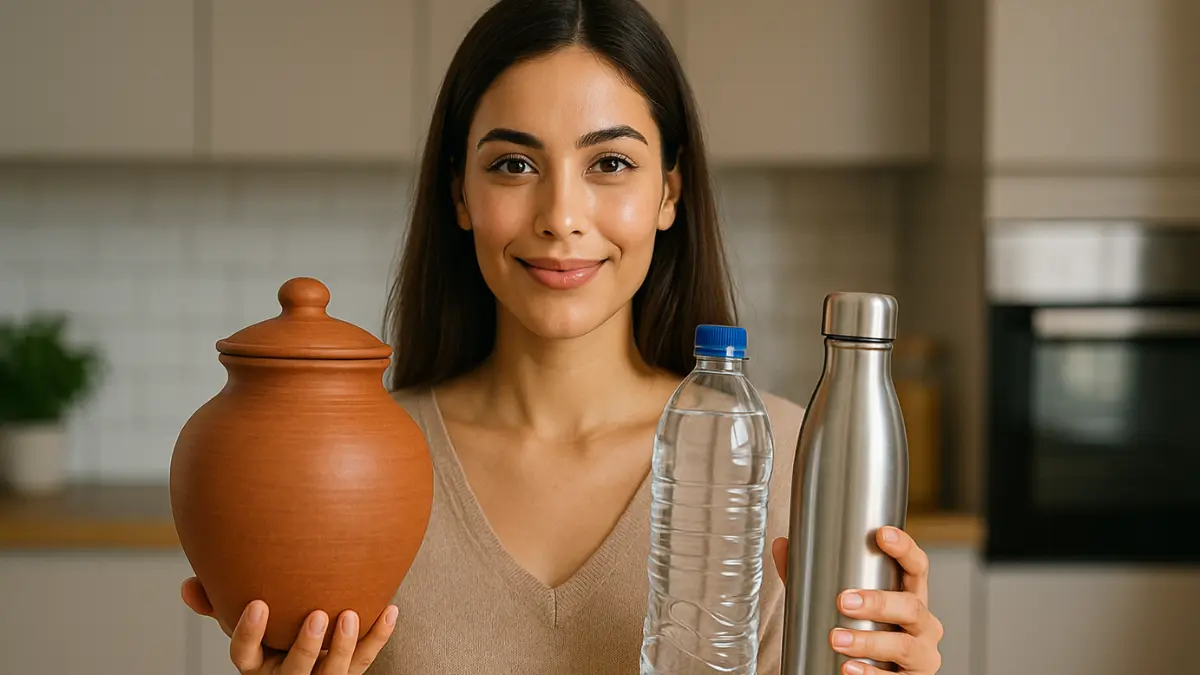When I Drank Clay Pot Water for a Week… Everything Changed
As a child visiting my grandmother’s home in Rajasthan, I remember sipping water from an old, earthy clay pot. It had a taste — not flavored, but fresh, raw, grounding. In our steel-bottle world and plastic convenience, I never gave it much thought until recently.
A few summers ago, feeling fatigued and bloated, I decided to ditch plastic bottles and try clay pot water again — just for a week. What happened surprised me: I felt lighter, more hydrated, and oddly more connected to nature.
So what’s the truth? Is clay pot water really better than plastic or steel? Or is this just old-school nostalgia? Let’s break it down.
What’s the Big Deal About Water Storage?
Water isn’t just H₂O. The container you store it in can impact its:
- Temperature
- Taste
- Toxicity
- Mineral interaction
- Energy or “pranic” value (as per Ayurveda)
From ancient Ayurvedic wisdom to modern scientific labs, the debate continues: Which vessel is healthiest — clay pot, plastic, or stainless steel?
Let’s explore.
🏺 Clay Pot Water — Ancient, Earthy, and Alive
Clay pots (known as matka or ghara) have been used in India for over 5,000 years. Their porous structure naturally cools water through evaporation and subtly enhances its taste.
✅ Benefits of Clay Pot Water:
- Natural Cooling Without Electricity
- No fridge? No problem.
- The pot’s micro-pores allow water to evaporate slowly, cooling it down naturally — a perfect solution in tropical heat.
- Balances pH & Alkalinity
- According to Ayurveda, clay pot water neutralizes excess acidity in the stomach and maintains a balanced dosha.
- Boosts Digestion
- Drinking clay pot water, especially in the morning, is said to stimulate the Agni (digestive fire) without shocking the gut with cold fridge water.
- Rich in Earth Energy (Prana)
- Ancient yogis believed clay-infused water absorbed the five elements — especially Prithvi (Earth) — making it energetically revitalizing.
- No Chemicals or BPA
- Unlike plastic, clay is free from synthetic compounds and microplastics.
- Taste That Feels Alive
- Many users claim the earthy, sweet taste of clay water is grounding and emotionally soothing.
- Eco-Friendly & Biodegradable
- No environmental guilt. When it breaks, it returns to the Earth.
🧪 Scientific & Ayurvedic Perspective
🔬 What Modern Science Says:
- Clay pot cooling is based on basic thermodynamics (evaporation). It’s energy-efficient and safe if the clay is lead-free.
- pH balance: Studies from Indian agricultural universities suggest water stored in unglazed clay pots is slightly alkaline — beneficial for health.
- Mineral absorption: Traces of minerals like calcium, magnesium, and iron may leach into the water naturally.
📚 What Ayurveda Believes:
- Drinking matka ka paani keeps the body’s Tridoshas (Vata, Pitta, Kapha) in harmony.
- Cold fridge water is considered Tamasic (dulling), while clay pot water is Sattvic (life-enhancing).
⚠ But Not All Clay Pots Are Safe…
- Glazed clay may contain lead or chemicals.
- Improper drying can cause mold or bacterial contamination.
- Always buy unglazed, sun-dried, lead-free pots from reputed sellers.
🧴 Plastic Bottles — Convenient but Concerning
We can’t deny the convenience of plastic. But at what cost?
❌ Risks of Plastic Bottles:
- Leaching of Toxins
- Plastics (especially non-BPA-free) can leach harmful compounds like phthalates and BPA into water, especially in heat.
- Microplastic Ingestion
- According to WHO, humans may ingest thousands of microplastic particles yearly via bottled water.
- Endocrine Disruption
- These chemicals mimic hormones and may disrupt metabolism, fertility, and immunity.
- Environmental Damage
- Over 1 million plastic bottles are bought every minute. Most end up in oceans.
- Stale Taste
- Ever noticed water in a plastic bottle left in the sun? Flat, plasticky, and unappealing.
✅ Safe Use Tips:
- If you must use plastic, opt for BPA-free, food-grade, ISI-certified brands.
- Never refill single-use bottles or expose them to heat.
🥄 Steel Bottles — Durable But Not Divine?
Stainless steel is the new favorite of the health-conscious crowd. And for good reason.
✅ Pros of Steel Bottles:
- Non-Toxic & Durable
- No BPA. No breakage. Long lifespan.
- Temperature Control (Double-Walled)
- Keeps water hot or cold for hours.
- Odor-Free
- Unlike plastic, steel doesn’t retain flavors or smells.
- Eco-Friendly
- Reusable for years.
⚠ But There’s a Flip Side:
- No Pranic Energy — As per Ayurveda, steel is neutral. It doesn’t energize water like clay does.
- May Leach Nickel or Chromium if of low quality.
- Gets Hot Fast if exposed to sunlight.
✅ Best Use: Great for traveling or storing warm herbal teas. But for daily hydration at home, it lacks the “soul” of clay.
🧘🏽♀️ My 7-Day Clay Pot Challenge: A Personal Note
After switching to a matka for just one week, I noticed:
- Less bloating
- More calmness post-meals
- Slight earthy aroma in water (pleasant!)
- My skin looked less dry, possibly due to better hydration
Was it placebo? Maybe. But it felt real. And sometimes, how we feel matters more than lab reports.
🥊 Final Comparison: Clay vs Plastic vs Steel
| Feature | Clay Pot 🏺 | Plastic 🧴 | Steel 🥄 |
|---|---|---|---|
| Taste | Earthy & refreshing | Flat or chemical-like | Neutral |
| Cooling effect | Natural cooling | None | Depends on insulation |
| Toxicity risk | Low (if unglazed) | High (if heated) | Low (if good quality) |
| Ayurvedic value | Sattvic (energizing) | Tamasic (dulling) | Neutral |
| Eco-friendliness | 100% biodegradable | Non-biodegradable | Reusable, recyclable |
| Portability | Fragile | Lightweight | Highly portable |
🙋♂️ People Also Ask: FAQs
1. Is clay pot water safe to drink?
Yes, if it’s from a lead-free, unglazed, sun-dried source. Clean it regularly and store in cool, dry places.
2. Does clay pot water help digestion?
According to Ayurveda, yes. It keeps digestive fire (Agni) balanced and reduces acidity.
3. Can I drink water stored in plastic bottles?
It’s best to avoid long-term use, especially in heat or sunlight. Opt for BPA-free plastics if necessary.
4. Which is better for kids — clay, plastic, or steel?
Steel is safest for young children due to durability. But at home, clay offers better health benefits.
5. Does clay pot water remove toxins?
Not directly. But it balances pH, and keeps the water cool and naturally alkalized.
6. How often should I change a clay pot?
Every 3–6 months, or when it develops cracks or odor.
7. Can I use a clay pot in winter?
Yes! Just ensure it’s not stored in overly damp environments to prevent mold.
8. Why does clay water taste better?
Its natural minerals and porous structure subtly enhance water’s flavor and feel.
🌱 Conclusion: The Vessel Matters
Water is sacred. It heals, nourishes, and sustains. But the way we store and consume it can either enhance or diminish its life-giving power.
If you’re seeking the most natural, health-aligned, and emotionally grounding option, the humble clay pot might just surprise you — as it did me.
🌿 Clay connects you to Earth. Steel protects. Plastic pollutes. Choose wisely.




